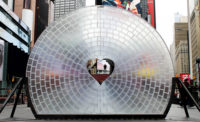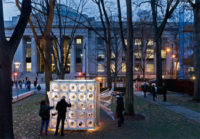Aranda\Lasch, NYC/Tucson
Two architectural designers, inspired by fractal geometry, scale up their designs—and their practice.
























NYC; Tucson
Most young architects start off with small projects (kitchen, baths) or art installations before getting meatier commissions. Aranda\Lasch’s methods for scaling up are a little different. Benjamin Aranda and Chris Lasch, trained as architects, created the short video The Brooklyn Pigeon Project when they launched their studio in New York in 2003. This ambitious experiment centered on a (shaky) bird’s-eye view of the city, starring Reuben, a slightly freaked-out pigeon who had a small camera strapped to his neck. In 2005, their book, Tooling (Pamphlet Architecture 27) explored computational methods and algorithmic codes that would guide them in their designs for furniture, installations, and collaborations with artists such as Matthew Ritchie.
Now Aranda\Lasch’s first building, the Art Deco Project, is due to open in March 2015 in the Miami Design District. The 44-foot-high rectangular volume houses four luxury retail shops for LVMH, with a Tom Ford boutique anchoring one corner. Its pleated surface of lightweight glass-fiber-reinforced-concrete (GFRC) panels evokes the linear bas reliefs of Miami’s Art Deco architecture. “We wanted to harness this history in a more systemic way,” says Aranda, who worked with SB Architects on the execution.
The project’s client, Craig Robins, CEO and president of Dacra, a Miami real-estate company, became interested in Aranda\Lasch in 2007, when he bought their Quasicabinet, a chest of lacquered wood in a crystalline-CNC-milled pattern. Robins had been transforming an 18-block area north of downtown into the Miami Design District by investing in art galleries, restaurants, and shops. Aranda\Lasch had made its debut in the city in 2006, showing exotic furniture in the Design Miami exposition (held annually with the Art Basel fair) through the New York-based Johnson Trading Gallery. In 2008 and 2009, they created tent-like structures to contain the fair before it moved from the Design District to Miami Beach. Now the two have just completed a permanent venue in the district, the Event Space at Palm Court, where Dacra and LVMH are creating a retail complex. A block from the Art Deco Project, Aranda\Lasch’s single-level structure of poured post-tensioned concrete with a crystalline pattern sits atop a two-story building they are renovating for more shops.
The two architectural designers met as students in the late 1990s at Columbia University’s Graduate School of Architecture, Planning and Preservation. Both found dean Bernard Tschumi’s “paperless studio” curriculum transformative. “We began developing a computational rule system,” says Aranda, “that would automate the process of our design.”
After they graduated, their evolving design approach led to their inclusion in the Museum of Modern Art’s (MoMA) exhibition Design and the Elastic Mind, in 2008. Asked by MoMA curator Paola Antonelli to address the problem of scale, Aranda\Lasch conceived Rules of Six, executed with scientist Matthew L. Scullin. The team’s wall-mounted piece explored fractal geometries to generate three-dimensional hexagonal forms.
Like the fractals represented in that work, the firm is going from small to larger construction in its practice. In addition to the Miami buildings, Aranda\Lasch won a competition in 2013 in Libreville, Gabon, for the Palais des Arts (a performance and event venue), which it is currently developing with architects Westlake Reed Leskosky and London engineers AKT II. And it now has two offices, the newer one being in Tucson, where Lasch moved with his family in 2010. The ample workspace there lets him oversee much of the prototyping and fabrication for the firm. But Lasch admits the process requires close attention. “Scaling up in design is one thing, but the larger challenge is managing the office as it takes on bigger projects,” he says.
Aranda\Lasch
FOUNDED: 2003
DESIGN STAFF: 6
PRINCIPALS: Chris Lasch, Benjamin Aranda
EDUCATION: Lasch: Columbia University, M.Arch., 1999; University of Illinois, Urbana, B.S., 1995. Aranda: Columbia University, M.Arch., 1999; University of California, Berkeley, B.A., 1995
WORK HISTORY: Aranda\Lasch, 2003-present
KEY COMPLETED PROJECTS: Palm Court Event Space, Miami, 2014; This Garden at This Hour, permanent art/furniture installation with Matthew Ritchie, U.S. Food and Drug Administration, Silver Spring, Maryland, 2014; Reconfigurable Furniture, public installation at the Phoenix Office of Arts and Culture, Phoenix, 2013; Modern Primitives, installation, Venice Architecture Biennale, Venice, 2010
CURRENT PROJECTS: Art Deco Project, Miami, 2015; Palais des Arts, Libreville, Gabon
WEBSITE: www.arandalasch.com
People |
Products |















